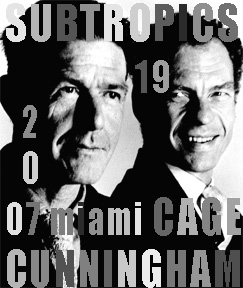
Subtropics Experimental Music &
Sound Arts Festival
February
23 – March 4, 2007
Carnival
Center for the Performing Arts
info@subtropics.org
SUBTROPICS 19
miami's experimental festival of
music and the sound arts
gustavo matamoros, artistic director
february 23 - march 4, 2007
merce cunningham and his dance company are
coming for
the first time to miami. and, it is fitting for subtropics
to jump at
the chance to revisit the music and legacy of one of the
festival's
favorite artists: composer JOHN CAGE
CONCERTS
schedule of concerts at
Carnival Center's Studio Theater
1300 Biscayne Boulevard, Miami
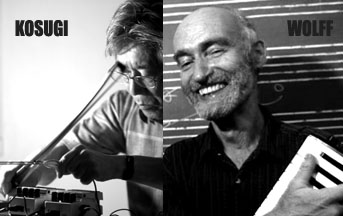
Saturday,
02/24/07
7 PM TAKEHISA KOSUGI
using violin, electronics and
video, composer takehisa kosugi will be
presenting a concert of mixed-media performing works.
the program will include his versions of the early
fluxus pieces organic music and micro 1
9:30 PM CHRISTIAN WOLFF
composer christian wolff
performs an evenning of his music for piano
a particular interest in his
work has been to allow performers flexibility and ranges
of freedom at the actual time of a piece's performance;
to devise notations to make this practicable; to foster
among both professional and lay players a spirit of
liberating interdependence; and to draw material from
traditions of popular political music
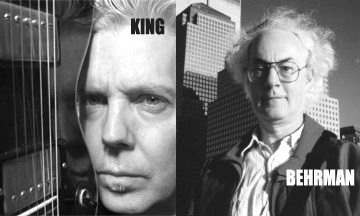
Sunday, 02/25/07
1 PM JOHN KING
composer john king
(guitarist/composer) performs his music for electric
guitar, electronics and video
he has performed live, solo and
interactive computer music with the electronic music
collectives unitygain and share at galapagos and open
air in new york city over the past four years
3 PM DAVID BEHRMAN
composer david behrman
performs his most recent electronic music
most of his pieces feature
flexible structures and the use of technology in
personal ways; the compositions usually rely on
interactive real-time relationships with imaginative
performers
9:30 PM I, IV, V by 5 + 1 the music of john cage
the music of subtropics
honoree, composer john cage featuring this year's
stellar subtropics ensemble of robert black on
bass, helena bugallo and amy williams on
piano, joan labarbara, voice, and jan williams
on percussion
FURNITURE MUSIC ETCETERA
helena bugallo and amy
williams
this piece for piano duet, combines, in a collage
fashion, portions of erik satie's musique
d'ameublement and cage's etcetera. cage
organized the duration and recurrence of events in
two parallel timetables, corresponding to each
performer. the assignment of musical events,
however, is made by the players. the title suggests
that the piece can exist as one component of a
larger environment. It will, therefore, take place
tonight as a sort of prelude to the concert, with
the piece and the sounds of the audience
intermingling.
RYOANJI
joan la barbara, robert black
and jan williams
ONE
helena bugallo
cCOMPOSED IMPROVISATION
robert black and jan williams
FOUR6 (1992)
joan la barbara, robert black
and jan williams and gustavo matamoros on
electronics
for any way of producing sounds (vocalization,
singing, playing of an instrument or instruments,
electronics, etc.). choose twelve different sounds
with fixed characteristics (amplitude, overtone
structure, etc.). play within the flexible
time-brackets given. when the time-brackets are
connected by a diagonal line, they are relatively
close together. - j.c.
FIVE
tutti
the five parts are for five voices or instruments or
mixture of voices and instruments. time brackets are
given. Within these the durations of tones are free,
as are their beginnings and endings, which should be
"brushed" in and out rather than turned on and off.
- j.c.
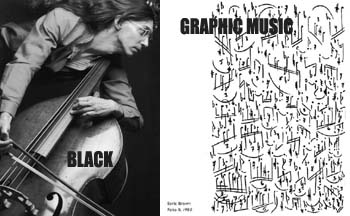
Monday, 02/26/07
7 PM ROBERT BLACK double bass
soloist robert black
performs the music of john cage, somei satoh,
james tenney and christian wolff
STRING BASS EXCERCISE
from 'BANDEITRA ROSSA' (1975) by christian wolff
BEAST (1971) by
james tenney
From 26'1.1499" FOR
STRING INSTRUMENT (1955) by john cage
THE THIRD SPELL
(2004) by somei satoh
LOOK SHE SAID (1991)
by christian wolff
9:30 PM GRAPHIC MUSIC the music of earle brown,
morton feldman and christian wolff
miami premieres of chamber
music from graphic scores by earle brown,
morton feldman and christian wolff featuring
the subtropics ensemble of robert black on bass,
helena bugallo and amy williams on piano,
joan labarbara, voice, gustavo matamoros,
saw, jan williams on percussion, with special
guest christian wolff on piano
FOLIO II (c. 1970)
by earle brown
tutti
FOR 1,2 or 3 PEOPLE (1964) by
christian wolff
robert black, jan williams and
christian wolff
FOLIO II (c. 1991) by earle brown
joan la barbara
IXION (for Piano Four Hands) by
morton feldman
helena bugallo and amy
williams
FOLIO II - E.B. for E. Blum (1994)
by earle brown
robert black
FOLIO II (1980) by earle brown
tutti
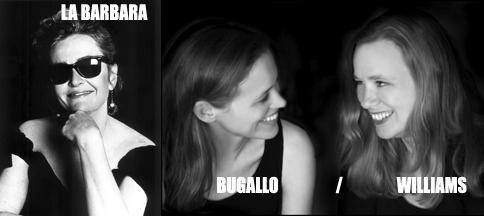
Tuesday, 02/27/07
7 PM JOAN LaBARBARA voice -
singing through cage
this program includes
selections for solo voice as well as for voice and piano
from her compact disc release joan la barbara -
singing through john cage (new albion na035). guest
pianist, amy williams
EXPERIENCES, No 2
for voice, unaccompanied (1948)
john cage composed this
music for the dance by merce cunningham and
completed it in 1948 in new york city. modal in
flavor, the entire work is constructed of only 5
pitches, arranged as shifting modular motivic
elements. cage experimented with notational
anomalies, for example, staccato and tenuto
articulation markings on the same notes, and with
using silence as negative space, juxtaposing the
presence of sound with the absence of it. there are
notated silent measures indicated with multipliers
of 3, 4 and 6, heightening the anticipation of the
next moment of music, or allowing us to reflect on
what has previously been heard. throughout his
compositional output, cage experimented with
different aspects of silence, the absence of
intentional sound and our expectations and
experiences of it, framed by the concert situation.
the most notorious example of this was his work
4’33” (1952), which consists of 3 sections all
designated tacet. the text used in "experiences no.
2" is from III, one of "sonnets – unrealities of
tulips and chimneys" (1923) by e.e.cummings
(appearing on page 62 of poems 1923-1954 by
e.e.cummings). regarding his setting of cummings’
poem cage wrote: “the last two lines were omitted.
other lines and a word have been repeated or used in
an order other than that of the original. the
humming passages (not part of the poem) are
interpolations.” the original poem is as follows:
it is at moments after
i have dreamed
of the rare entertainment of your eyes,
when (being fool to fancy) i have deemed
with your peculiar
mouth my heart made wise;
at moments when the glassy darkness holds
the genuine apparition
of your smile
(it was through tears always) and silence moulds
such strangeness as was mine a little while;
moments when my once
more illustrious arms
are filled with fascination, when my breast
wears the intolerant brightness of your charms:
one pierced moment
whiter than the rest
- turning from the
tremendous lie of sleep
i watch the roses of the day grow deep.
[note by joan la barbara]
A FLOWER (1950)
although "a flower" (1950) is
wordless, it opens gradually and introduces two
startling moments when the vocalist is instructed to
sing “like a pigeon” and “like a wild duck”. cage
indicates that it is to be sung in vocalize without
vibrato, except, where indicated, as a rapidly
repeated sound but not a pitch change.
ARIA (1958)
uses five languages: armenian,
english, italian, french and russian, and ten
different vocal styles to be chosen by the singer,
interspersed with silences indicated by page space.
the shape of the graphic suggests the contour and
direction of the vocal line, with vertical space
indicating pitch terrain. colors are used to assist
the singer in reading the score and shifting from
one (pre-determined) vocal style to another. [note
by joan la barbara]
MIRAKUS 2 (1984/85)
are to be sung without
vibrato, as in folk-singing, as lines of poetry,
with spaces between lines suggested by numbers
following each line. the texts are designed as "mesostics”,
that is between two capitalized letters neither of
the two appear, and are derived from “marcel duchamp,
notes” by alexina s. duchamp and paul matisse. they
are called “mirakus” in reference to “mirage
verbal”, the central vertical line, and “haikus”,
the japanese short poetical form. cage used the i
ching to determine the collection of pitches.
[note by joan la barbara]
SOLOS FOR VOICE 49 AND 67 from
"songbooks" (1970)
song books (1970) is a
collection of 56 parts in "book I" and 34 parts in
"book II." these vocal solos and theatrical pieces
may be sung alone or simultaneously with other solos
or with specific selections of cage’s indeterminate
music. the techniques cage used in determining the
pitches and durations in these songs include
tracings of star maps and distributing materials
over page space by means of chance operations
determined by the i ching, the chinese book
of changes. “solo for voice 49” uses a fragment from
henry david thoreau’s journal. “solo for voice 67”
(subtitled navajo yei-bi-chi) is accompanied by the
sound of a pile driver. [note by joan la barbara]
- intermission -
EIGHT WHISKUS (1984)
eight whiskus (1984) was
composed for joan la barbara and premiered
during her 1985 recital series “new works for the
new voice” at symphony space in new york city. using
“mesolist” and “i”, programs designed for cage by
jim rosenberg and andrew culver, respectively, eight
“mesostics” were written on a text by austalian poet
chris mann, using the first three words of
the text, “whistlin is did” as the central vertical
row. (the rule for a “mesostic” is that between two
capitalized letters neither of the two appears.) the
“kus” of the title refers to the short poem form,
haiku and “whis” is, of course, taken from “whistlin”.
when cage presented me with these songs, he played
them on a toy piano, the only keyboard in his loft
apartment at that time. he was so pleased with the
results of "eight whiskus" that he composed a series
of vocal works, all with titles ending in “kus”.
a fragment of mann’s original text appears below:
“whistlin is did be
puckrin up th gob n blowin thru a ol a brownie
sod th box n i seen a compo front up n stack on
a blue a bit of a spoon th doodlers hump arguing
by buying up all buns n juice crack a fudge a
droopie go th roy n late th light not worth a
pinch a *bleep* the Big H geech n that’s a fine
how d y do 1234 doin twos a whos up who n
blinkin cheek a one jump sit y ring n warby
kinda facts that double dutch or wear th daks n
though I says it as shouldn’t the lips yd smack
d be th biggest dill y meet ”
MUSIC FOR THREE (BY ONE)
(1984)
“music for … “ consists
of up to seventeen parts for voice and instruments
without score, the title of which is completed by
adding to “music for …” the number of player
performing. In this case, la barbara has chosen
superimpositions of different sections of the score,
layering two parts on tape and adding a third
section live.
ONE 7 (1990)
one7 (1990) belongs to
cage’s final series of “number” pieces in which time
brackets indicate when a sound is to begin and end.
numbers indicate different sonic material to be
chosen at the discretion of the player. the solo
"one7" is taken from "four6," composed for joan
la barbara, leonard stein and william winant
which was performed by them with cage at his final
concert appearance july 23, 1992 at summerstage in
new york city’s central park.
THE WONDERFUL WIDOW OF EIGHTEEN SPRINGS
(1942)
the wonderful widow of
eighteen springs (1942) uses just three pitches
to explore fragments from james joyce’s “finnegan’s
wake” with rapping and tapping on the piano body and
closed keyboard cover hinting at sounds of a strange
forest.
NOWTH UPON NACHT (1984)
nowth upon nacht is a
companion piece, composed in 1984 in memoriam cathey
berberian. It also uses texts from “finnegan’s wake”
but, in sharp contract to the serenity of the work
which precedes it, this is to be sung like a wild
banshee shriek.
9:30 PM BUGALLO/WILLIAMS piano duo
this program is organized
around two polar opposites: the highly deterministic,
mechanical music of conlon nancarrow's studies
for player piano and the highly in-deterministic
feldman work, two pianos. lying somewhere in
between these extremes are pieces by salvatore sciarrino
and an unusually “free” canon for two pianos, also by
nancarrow
STUDIES FOR PLAYER PIANO
#3b, #20, #9 by conlon nancarrow
discouraged by poor
performances of his early works, including the
sonatina (originally written for solo piano—here
performed in an arrangement by yvar mikhashoff for
piano four-hands), conlon nancarrow turned to the
player piano in the late 1940s. the "sonatina" is
the first work that nancarrow punched onto paper
rolls, in order to be able to hear it accurately
represented. this led him to an exhaustive
exploration of this unusual medium, resulting in a
series of approximately fifty studies for player
piano, both highly idiomatic and utterly original.
canonic procedures, particularly those in which the
voices are in different speeds, are used in nearly
all the "studies," ranging from polyrhythmic
imitation (#3b, #6, #9) to strict polytempo canons
(#20, #32, #18, #15). these studies require absolute
precision in performance, with limited
interpretational freedom in regards to phrasing and
dynamics. after repeated, failed attempts to
precisely synchronize his two player pianos,
nancarrow opted to introduce an aleatoric component
in the conception of study #44. the work’s
unusual focus is thus on the always-evolving
relationship between the two parts, rather than on
their exact temporal relationship. he wrote: "this
piece is for two non-synchronized pianos (a & b).
the piece is so designed that the two parts can be
played at any temporal relationship. best results
are obtained if one part is played at a tempo that
takes about one minute to complete one cycle and the
other at a tempo slightly faster or slower, so that
both can go through about ten cycles, with each
cycle producing a slightly different relation
between the two parts."
SONATINA by conlon nancarrow
TWO PIANOS by morton
feldman
this piece was premiered in
december 1957 by david tudor and john cage. precise
pitches are indicated (as opposed to his entirely
graphic scores from around the same time), but not
rhythms. as in "study #44," both pianists play the
same music, but, because of the rhythmic freedom,
the effect is of a canon with constantly shifting
roles of “leader” and “follower.”
STUDY FOR PLAYER PIANO #44 (aleatory
canon) by conlon nancarrow
SONATA FOR TWO PIANOS
by salvatore sciarrino
the music of italian composer
SALVATORE SCIARRINO often places great
demands on the instrumentalists, especially by
challenging traditional methods of playing. In his
very early SONATA FOR TWO PIANOS, the two
performers must simultaneously operate in two
mindsets: one characterized by a great deal of
indeterminacy (no precise rhythms, pitches,
dynamics, or tempi are specified) and the other
dominated by extremely precise ornamentation (black
and/or white note glissandi of varying lengths, no
less than fourteen different types of trills, and a
wide range of clusters). the gesture of
ornamentation is brought to the forefront. the work
is in two movements: sonata allegro and minuet/trio.
the “classical” devices of imitation, themes,
diatonicism, modulation, development and
recapitulation are clearly incorporated, but with an
entirely novel sonic result.
STUDIES FOR PLAYER PIANO #32, #18, #6,
#15 by conlon nancarrow
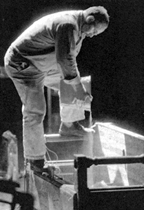
Wednesday, 02/28/07
7 PM SUBTROPICS MARATHON new
music by various festival artists
the 19th edition of the
subtropics marathon will include performances and works
by russell frehling, juraj kojs, juan
carlos espinosa, rene barge, armando
martinez, and other south florida based artists.
this year's marathon special guest is the fabulous
margaret lancaster, the new music flautist from new
york. she will be performing works by tampa based
bonk festival composers and other works of
historical importance
JARAK JAUH for
piccolo/flute/alto flute and tape by nicholas brooke
this piece is inspired by the
saluang tradition of west sumatra, in which two
flutes play a single melody in close unison; subtle
differences in each saluang’s tuning and rhythm
create a shimmering filigree. In jarak jauh,
margaret plays against a recorded doppelganger of
herself, which begins in distant canon. slowly, the
flutes become one. sumatran saluangs also enter the
mix, further blurring the distinction between live
musician and recording. the piece is influenced by
the keening, chromatic tradition of some western
sumatran music, in which the singer often bemoans
the fact that one’s “other half” is missing or
distant. In the matrilineal culture of west sumatra,
men tend to merantau, or travel far away in search
of a livelihood, leaving the women to sing about
their absence. “jarak jauh” means long distance.
performed by margaret lancaster
SEEGERSONG #2 for
solo flute by james tenney
james tenney’s
seegersong #2 for solo flute is a spatial
exercise whose structure unfolds subtly and
lyrically to trancelike effect. it was composed in
1999 for katrin zenz on the occasion of the birth of
her daughter eleftheria. performed by margaret
lancaster
IN PRAISE OF BUDDY
HACKETT for flute and tape by paul reller
this piece is written for
and dedicated to margaret "the lung" lancaster,
the only human yet able to play it, for both
physical and aesthetic reasons. even midi flutes
tire. buddy hackett is an american actor and
spiritual leader. the hindus believe that everyone
is god. performed by margaret lancaster
THE NEW IMPROVED TRUTH,
BOOK III for flute and tape by eric lyon
like everything else, the
truth can always be improved upon. the current truth
might not make good people look good enough or bad
people look bad enough. the selection of just the
right photograph to make someone look more
presidential, or more menacing, adds that extra
sparkle to the truths reported in our media.
strategic cropping of images, darkening the
complexion of a face, editing out distracting and
non-essential civilian body counts; these are all
necessary tools for portraying the higher truth. the
pursuit of better and better truth is a universal
historic process. whoever creates the best truth
wins. can you handle the truth? performed by
margaret lancaster
FLUXATION No 2
(1992) by russell frehling
performed by gustavo matamoros
UNTITLED: ARTIFACTS /
LONG LINES (2004) video by russell frehling
the soundtrack is part of a
series called untitled/artifacts, which was
started back around 1982 as a vehicle in which sound
materials collected for installation projects could
be developed in a live performance context. from the
surrounding ambient noise extremely short segments,
a few thousandths of a second long, are extracted
and looped in such a way as to render them
essentially static; the way that a photograph has
the ability to freeze a subject in motion. these
"frozen" waveforms (these days often referred to as
"grains") are cascaded over time to create a
continuously evolving sound. this technique is a way
of deconstructing the ambient soundscape into its
elemental components and reconstructing a new sonic
encounter. regarding longlines the video - as
with most of my work i tend to deal with the mundane
stuff of my day to day world. this video is shot on
my commute route to new york city via amtrack/subway.
i used extremely high shutter speeds to capture the
details of structures that are normally a blur.
AIR FOR FUJARA AND
ELECTRONICS (2006) by juraj kojs
air is a composition
scored for the physical and virtual fujaras. the
composition presents a communication between the
ancient bass pipe instrument and its ditigally
modeled replica. the virtual fujara designed by
stefania serafin extends the frequency range,
amplitude envelope contour and duration, and timbre
of the physical instrument. the model further
facilitates circular breathing, an effect that is
impossible to achieve by the physical fujara. the
composition elaborates on breathing and overblowing
patterns of various durations, shapes, and
intensities. pitch material of 'air' is derived from
the slovak folk music. formally, the composition
follows the trajectory from the idiomatic sound of
the physical fujara to the sounds produced by
extended performance techniques, and, finally, to
the sonorities of the physical model.
ALL FORGOTTEN FOR PIANO
AND ELECTRONICS (2006) by juraj kojs
all forgetten belongs
to a series of pieces inspired by poetry of st.
john of cross. these compositions explore
instrumental sonorities that lie on the border of
hearing. the piano part is executed inside the
instrument while bowing the strings with the
fingers. the electronic part uses the "max/msp"
implementation of the marimba physical model
designed by stefania serafin. extending the
instruments‚ possibilities beyond the limitations of
the physical world, the virtual marimbas enable
production of high and low tones not performable on
the physical instrument, sustained excitation of the
tones, tone repetition as fast as 1 event per 1
millisecond, real-time change of the beater
qualities, and extremely rapid repositioning of the
beater on the bar. while straining both physical and
virtual instruments, 'all forgotten' releases
suppressed beauty hidden in the tensed piano strings
and dense marimba bars.
OPEN PIANO by juan
carlos espinosa
EREBUS (2007) by
juan carlos espinosa
HAL 9000 video by
shaun vendryes
RESKINTHESIS by
armando martinez
is an excursion into the world
of percussive surfaces. the prevelant skins used for
hand drums throughout time, namely goat, cattle, elk
and buffalo are recorded into resynthesis software
and morphed with raw waveforms to produce new exotic
surfaces. these new textures are then sequenced,
cut-up and processed with computer software whilst
maintaining true to the intent of early human rhythm
and non-linear percussive ideas.
200
WATTS(1997-2007) by gustavo matamoros
one sealed envelop is handed
to each member of the audience that must not be open
until instructed to do so
20 TITLES (c. 1980)
plus performances of
seminal experimental and avant-garde works that
include:
VOICE by toru
takemitsu
CELESTIAL MUSIC by
tom johnson
SONIC MEDITATION by
pauline oliveros
IONISATION by edgard
verese
CRITICAL BAND by
james tenney
MUSIC OF CHANGES by
john cage
IN C by terry riley
THE KING OF DENMARK
by morton feldman
and others as performed by
estellar musicians and ensembles from across south
florida
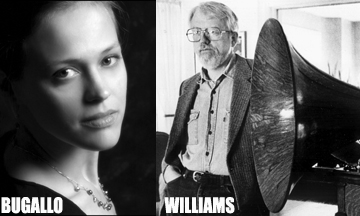
Thursday, 03/01/07
7 PM HELENA BUGALLO
helena bugallo performs the
90-minute long work triadic memories for solo
piano by morton feldman
TRIADIC MEMORIES by
morton feldman
"morton feldman
completed triadic memories for solo piano on
july 23, 1981. it is dedicated to the avant-garde
pianists aki takahashi and rodger woodward, and is
the composer's most famous piano work. consisting of
over 1100 measures, it is also the longest. there is
no designated tempo; performances and recordings can
vary in duration from seventy to ninety minutes.
only a few notes, generated from a sparse, two-bar
musical cell, is the basis for all the ensuing
material. this extreme economy does not betray a dry
or deliberately challenging work. it is not
especially demanding music, but rather it is
inventive, beautiful, and never boring. one can only
be amazed after listening to such an unprecedented
achievement; most works of this length require the
composer to fill it with as many diverse elements as
possible in order to keep it interesting." ~ excerpt
from review in All Music Guide
9:30 PM JAN WILLIAMS
percussionist jan williams
performs an intermedia percussion concert featuring
music by early fluxus composer la monte young and
miami's gustavo matamoros
WILLIAMS TELLS OF RIGHTS
(1997-2005) by gustavo matamoros
a song for snare drum written
for jan williams. the sound text is built around the
sound of the word “right” as used in the english
language. when it appears, the word "right" is read
aloud into a snare drum while the rest of the text
is spoken softly. a long roll of the letter "r" is
necessary to cause the snare drum to trill each time
the word "right" is spoken
591 TO H.F. (1960) by la monte
young
PICKUP STICKS (1998)
by gustavo matamoros
a game of chinese pickup
sticks is played over an amplified drum skin, its
image also amplified several times its real size on
a video screen. the task: try not to make a sound!
in this snare drum piece it is the mistakes that
release sonic "dreams & spirits" conceptually
contained inside drum
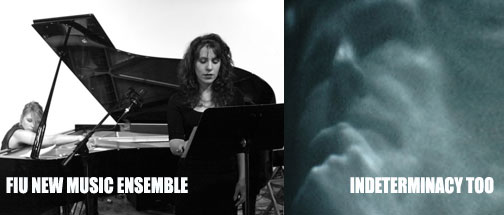
Friday, 03/02/07
7 PM FIU NEW MUSIC ENSEMBLE
chamber music by earle brown,
john cage, morton feldman and lou
harrison
FOLIO and 4 SYSTEMS
VERSION 1 by earle brown
eliot rodriguez, clarinet;
michael davis, viola; david mendoza, viola; edward
shannon, viola; marta milosevic, piano; orlando
jacinto garcia
4 INSTRUMENTS by morton feldman
rafael galvan-herrera, violin;
roxana mendoza-guevara, cello; michael davis, viola;
daniel venegas, piano; orlando jacinto garcia,
conducting
PRIMITIVE for prepared piano by
john cage
marta milosevic, piano
VARIED TRIO by lou harrison
rafael galvan-herrera, violin;
daniel venegas, piano; zack eldridge, percussion
FOLIO and 4 SYSTEMS VERSION 2 by
earle brown
eliot rodriguez, clarinet;
michael davis, viola; david mendoza, viola; edward
shannon, viola; marta milosevic, piano; orlando
jacinto garcia, conducting
9:30 PM INDETERMINACY TOO john cage oral histories
project
this oral histories project,
constructed during the festival, will feature stories
and anecdotes about john cage compilled from the
numerous festival artists and attendees who new him
personally. this video and sound event is organized by
the interdisciplinary sound arts workshop in
collaboration with laura kuhn, driector of the
john cage trust, and barron sharer of
cinema vortex
COMUNITY EVENTS
Saturday, 03/03/07
FLUX DAY
Those who will attend and
participate in the many FLUXUS DAY activities on
March 3 in Miami may come to understand why Fluxus has
been simultaneously called both “high art” and “low
art.” Fluxus is an oddly ambiguous Latin word which, for
over 40 years now, has been applied to a celebrated
group of composers, musicians, artists, writers, poets,
dancers, and other art professionals who were pioneers
in developing interdisciplinary art. The original Fluxus
artists formed a pillar of 20th Century Art, and its
hard-to-define principles are still being expounded upon
by art historians and excited young artists of today
11:00 AM - FLUXUS ON THE
BEACH
events on lincoln road and out
to sea in miami beach
2:30 PM - FLUX FAIR
events at carnival center's
plaza of the arts in the main land
9:30 PM - FLUX EVE
a concert at carnival center's
studio theater
Sunday, 03/04/07
10:00 AM to MIDNIGHT erik
satie's VEXATIONS
at carnival center's knight
concert hall
Saturday, 03/03/07 - FLUX DAY
11:00 AM - FLUXUS ON THE BEACH
FLUXUS ON THE BEACH
Fluxus has proven to be
resilient and au currant! This will be seen on
Miami’s Flux Day when New York Fluxus artists Alison
Knowles and Larry Miller present PIANO ODYSSEY (A
Trojan Horse), an event specially created for
Miami Beach starting at 11 AM at 800 Lincoln Road
and traveling in a straight line to the sands of
Miami Beach's eastern shore. Knowles and Miller,
along with Gustavo Matamoras and others will perform
classic works from the Fluxus repertoire of piano
compositions and will present other events along the
way, creating a unique opportunity for viewers to
participate in a sonorous Fluxus journey to the sea.
This event will be dedicated to the late Fluxus
artist Nam June Paik, who was a long time
Miami Beach resident along with his wife Shikego
Kubota, an internationally celebrated Fluxus and
video installation artist. For this occasion, a
selection of works from George Maciunas’s 12
COMPOSITIONS for NAM JUNE PAIK (1962) will be
performed during the “Odyssey” and the evening
concert. A variation of Benjamin Patterson’s A
VERY LAWFUL DANCE (1962), and Eric Andersen’s
OPUS 1054 (early 1960s), which requires the
simultaneous precision of four pianists, will be
presented along the way.
On the beach, Knowles will premier her new work
SHORELINE, using a sewing machine and assistants
who will aid in building the work. Miller will
conduct and perform other selected works; a
highlight among them will be the rarely produced
88 NOTES by Albert Fine in which an article of
clothing is removed for each of the notes played.
The piano will have an important function at the
beach site, in the finale of its journey. Arranged
by Miller, the pianist, will play themes from
Debussy’s “La Mer”, as Miller pays homage to Nam
June Paik, (Atlantis Pirate for Paik 2007).
An additional element will provide challenges for
all participants: Selected events from the legendary
FLUX SPORTS will offer the public – including
children of all ambulatory ages – to participate in
out-of-the-ordinary sports diversions. These may
include such unusual contests as BLOW SOCCER
(in which long small tubes are used to propel a
ping-pong ball by breath alone) or BEACH
BADMINTON, using rackets with six-foot long
handles. For those who bring bikes there will be a
SLOW BICYCLE RACE (last one across the line
wins). Couples can dance to Ben Vautier’s TANGO.
And finally, the most likely contended event of all
will be the ZEN DASH. You must be there to
get the instructions.
And, bridging the geographical gap between FLUXUS ON
THE BEACH and FLUX FAIR (back in the main land),
Miami will experience the premiere of BAND MUSIC
No 1 by gustavo matamoros, a moving piece
involving the members of a marching band
Saturday, 03/03/07 - FLUX DAY
2:30 PM - FLUX FAIR (DO THE BEST
YOU CAN)
back on the main land, at the
carnival center's outdoor plaza of the farts,
come enjoy part 2 of this fluxus day extravaganza and
participate in the numerous fluxus activities and
challenges rearranged by gustavo matamoros for
participation by young and old. the different FLUX FAIR
booths will include fluxus classics like:
OPERA INSTRUCTION
(1961) by eric anderson
RAINBOW #1 FOR ORCHESTRA
by ay-o
RAINBOW #2 FOR ORCHESTRA
by ay-o
CHOISE 12 (1966) by
robert bozzi
INCIDANTAL MUSIC No 2
(1961) by george brecht
INCIDANTAL MUSIC No 3
(1961) by george brecht
OCTET FOR WINDS
(1964) by george brecht
SALE (1962) by ben
vautier
AUDIENCE PIECE No 10
(1965) by ben vautier
WIND MUSIC No 2
(1966) by mieko shiomi
C/S TRACE (1963) by
robert watts
MUSIC FOR PIANO NO. 5
(FLUX-VARIATION) by toshi ichiyanagi
...and more.
Saturday, 03/03/07 - FLUX DAY
9:30 PM - FLUXUS EVE CONCERT
join alison knowles,
larry miller and a battery on miamians in a concert
of classical fluxus pieces
during the FLUXUS EVE
concert at the carnival center's studio
theater, alison knowles and larry
miller will perform some of their own
compositions as well a diverse selection chosen from
fluxus works by various artists such as eric
andersen, ay-o, george brecht, philip corner, dick
higgins, Toshi Ichiyanagi, joe jones, bengt af
klintberg, takehisa kosugi, milan knizak, george
maciunas, yoko ono, ben patterson, willem de ridder,
takako saito, tomas Schmit, miieko shiomi, yasunao
tone, ben vautier, yoshi wada, robert watts, and
emmett williams. gustavo matamoros and a small group
of musicians and performers will join the concert.
knowles and musicians will perform her work ONION
SKIN SONG and with multiple readers, will
conduct her classic NEWSPAPER MUSIC. miller
will perform REMOTE MUSIC (FOR KEYBOARD)
1976, known for its minimalist fluxus style. a
highlight of the evening will be the presentation of
george brecht’s MOTOR VEHICLE SUNDOWN EVENT (for
john cage), most recently directed by miller in
front of the dom cathedral in cologne, germany in
2005. in that version there were over 40 vehicles,
but the miami realization will have an unexpected
approach to the piece.
as miller explains, “a fluxus concert is
characterized by the willingness of artists to
collaborate at the most creative essence, to carry
that impulse through on behalf of a group
intelligence, and to sense the original spirit
shaped by the unique time and place in which the
events takes place.”
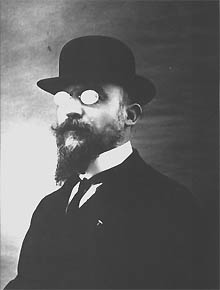
Sunday, 03/04/07 - 10 AM to
MIDNIGHT
erik satie's VEXATIONS
lobby at carnival center's knight
concert hall
this colossal piano performance gathers the energies of 30
pianists, both veteran icons of our community as well as
young upcoming talents, and puts them to the test, each
contributing 28-minute segment of the first miami
performance of this 14-hour long piece. the list includes:
guests of honor: ruth greenfield
and velia yedra
plus dennis kam, adrian
quesada, juraj kojs, and more ...
10:00 AM pianist 1
10:28 AM pianist 2
10:56 AM pianist 3
11:24 AM pianist 4
11:52 AM pianist 5
12:20 PM pianist 6
12:48 PM pianist 7
01:16 PM pianist 8
01:44 PM pianist 9
02:12 PM pianist 10
02:40 PM pianist 11
03:08 PM pianist 12
03:36 PM pianist 13
04:04 PM pianist 14
04:32 PM pianist 15
05:00 PM pianist 16
05:28 PM pianist 17
05:56 PM pianist 18
06:24 PM pianist 19
06:52 PM pianist 20
07:20 PM pianist 21
07:48 PM pianist 22
08:16 PM pianist 23
08:44 PM pianist 24
09:12 PM pianist 25
09:40 PM pianist 26
10:08 PM pianist 27
10:36 PM pianist 28
11:04 PM pianist 29
11:32 PM pianist 30
12:00 AM
INSTALLATIONS

February 23 - March 4, 2007 -
EXHIBITION
CAGE: RELEASED IN MIAMI
an intermedia installation
comprised of materials from iSAW's Experimental Sound
Archive, in colloaboration with the Louis Wolfson II -
Florida Moving Image Archive and Deluxe Arts.
OPENING RECEPTION:
Friday, February 23, 2007 - 6-9 PM
Deluxe Arts
2051 NW 2 Avenue, Miami
305 858 7735
www.subtropics.org
|
